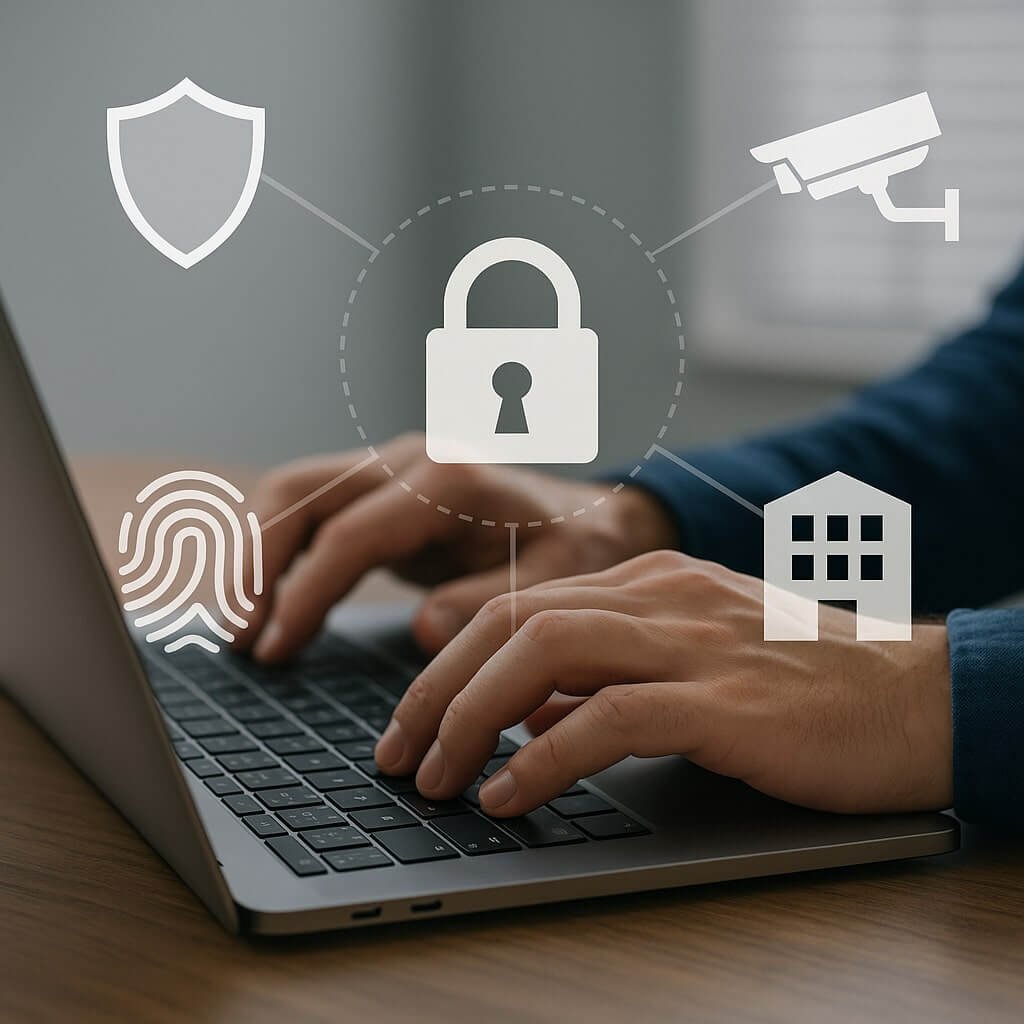In today’s digital landscape, enhancing your network security is not just a priority—it’s a necessity. By systematically evaluating your current security posture and identifying vulnerabilities, you can lay a solid foundation for improvement. Implementing strong password policies and multi-factor authentication is essential, but that’s only the beginning. As threats evolve, your strategies must adapt. So, what specific steps should you take to guarantee your network remains resilient against potential breaches?
Key Takeaways
- Assess the current network security posture by identifying vulnerabilities and existing security measures to prioritize risks effectively.
- Implement strong password policies and multi-factor authentication to enhance account security and deter unauthorized access.
- Utilize firewalls and Intrusion Detection Systems while regularly updating software and hardware to maintain robust network defenses.
- Conduct regular employee training programs to raise awareness about cybersecurity threats and promote a culture of security within the organization.
- Monitor network traffic and develop an incident response plan, ensuring regular data backups for integrity and compliance.
Assess Your Current Network Security Posture
Before you can enhance your network security, you need to thoroughly assess your current security posture.
Start with a thorough network assessment, identifying all devices, applications, and data flows. Evaluate your existing security measures, including firewalls, intrusion detection systems, and endpoint protections.
Conduct a security evaluation to pinpoint vulnerabilities and assess threats that may exploit them. Utilize tools like vulnerability scanners and penetration testing to gather data on potential weaknesses.
Document your findings meticulously, prioritizing risks based on their potential impact. This detailed analysis not only establishes a baseline for security enhancements but also guides future investments in security technologies.
Implement Strong Password Policies
Implementing strong password policies is essential for safeguarding your network against unauthorized access. You should enforce password complexity by requiring a mix of uppercase letters, lowercase letters, numbers, and special characters. Additionally, consider integrating multi-factor authentication to add another layer of security.
Here’s a quick reference table for effective password policies:
| Policy Aspect | Recommended Action | Importance |
|---|---|---|
| Password Length | Minimum 12-16 characters | Increases resistance to attacks |
| Password Change Frequency | Every 60-90 days | Limits exposure from leaks |
| Account Lockout | Lock after 5 failed attempts | Deters brute-force attacks |
| Multi-Factor Authentication | Always enabled | Enhances security considerably |
Utilize Firewalls and Intrusion Detection Systems
To effectively bolster your network security, utilizing firewalls and intrusion detection systems (IDS) is vital. Firewalls act as a barrier between your internal network and potential threats from the internet, controlling incoming and outgoing traffic based on predefined firewall configurations.
Make sure you regularly review and update these configurations to adapt to evolving threats. Meanwhile, IDS monitors network traffic for suspicious activities, providing real-time alerts to potential intrusions.
For enhanced security, consider implementing intrusion prevention systems (IPS), which can actively block detected threats. By combining firewalls with IDS and IPS, you create a multi-layered defense, considerably reducing the risk of unauthorized access and data breaches.
This proactive approach is pivotal for maintaining the integrity of your network.
Regularly Update Software and Hardware
To maintain robust network security, you must prioritize timely updates for both software and hardware.
Neglecting these updates can expose vulnerabilities that attackers readily exploit.
Automating the update process can streamline this critical task, ensuring your systems remain fortified against emerging threats.
Importance of Timely Updates
While many organizations understand the need for robust security measures, they often overlook the critical role of timely updates in maintaining their network integrity.
Adhering to a strict update frequency can greatly enhance your security posture and mitigate vulnerabilities. Effective patch management is essential for ensuring that all software and hardware components remain protected.
Here are key reasons why timely updates matter:
- Vulnerability reduction: Fixes security flaws before they’re exploited.
- Improved performance: Enhances system efficiency and stability.
- Compliance requirements: Meets industry standards and regulations.
- User confidence: Builds trust with customers and stakeholders.
- Threat intelligence: Keeps you informed about emerging threats.
Automate Update Processes
Timely updates greatly bolster network security, but manually managing these updates can lead to oversight and delays. Automating update processes through automated patching and update scheduling guarantees that your software and hardware remain current without constant manual intervention. This reduces the risk of vulnerabilities due to outdated systems.
Here’s a quick overview of the benefits of automating your updates:
| Benefit | Description | Impact |
|---|---|---|
| Increased Security | Reduces vulnerabilities | Higher protection level |
| Efficiency | Saves time on manual updates | Frees up IT resources |
| Consistency | Guarantees uniformity across devices | Standardized security |
| Timeliness | Guarantees updates are applied promptly | Immediate threat mitigation |
| Compliance | Meets regulatory requirements | Avoids potential fines |
Conduct Employee Training and Awareness Programs
To enhance your network security, conducting regular employee training and awareness programs is essential.
Cybersecurity threats evolve constantly, and keeping your team informed helps mitigate risks effectively.
Importance of Cybersecurity Training
Understanding the significance of cybersecurity training is crucial for any organization aiming to fortify its defenses against cyber threats.
Training fosters employee engagement and enhances training effectiveness, ensuring that your team is well-prepared to identify and mitigate risks.
Here are key benefits of implementing robust cybersecurity training programs:
- Increased Awareness: Employees recognize potential threats and vulnerabilities.
- Reduced Risk: Well-informed staff can prevent security breaches.
- Compliance: Training helps meet regulatory requirements.
- Improved Response: Employees are better equipped to respond to incidents.
- Culture of Security: Fostering a security-first mindset across the organization.
Investing in cybersecurity training is essential, as it empowers your workforce to act as the first line of defense against emerging cyber threats.
Regular Awareness Workshops
Building on the foundation of cybersecurity training, regular awareness workshops play a pivotal role in reinforcing knowledge and skills among employees. These workshops enhance employee engagement, ensuring that everyone understands the latest security threats and best practices. To maximize effectiveness, consider the following workshop frequency options:
| Workshop Frequency | Description |
|---|---|
| Weekly | Short, focused sessions |
| Bi-weekly | In-depth discussions |
| Monthly | Extensive reviews |
| Quarterly | Industry updates |
| Annually | Full-scale evaluations |
Implementing a structured schedule not only keeps security top-of-mind but also allows for continuous adaptation to evolving threats. Regular workshops create a culture of security awareness, empowering employees to act as the first line of defense against cyber risks.
Establish Access Controls and User Permissions
While establishing access controls and user permissions may seem straightforward, it’s a critical step in fortifying your network security. You need to guarantee that only authorized personnel have access to sensitive data and systems.
Implementing robust user authentication methods and defining user access levels are essential. Consider these key strategies:
Implementing strong user authentication and clearly defined access levels is vital for maintaining network security.
- Define user roles based on job functions.
- Utilize multi-factor authentication for enhanced security.
- Regularly review access permissions to prevent privilege creep.
- Limit administrative access to essential personnel only.
- Educate users on the importance of security and their responsibilities.
Monitor Network Traffic and Logs
Monitoring network traffic and logs is essential for maintaining a secure environment. By conducting thorough traffic analysis, you can identify unusual patterns that may indicate security threats. Effective log management allows you to capture, store, and analyze data, ensuring that you have the necessary insights when investigating incidents.
| Activity | Purpose |
|---|---|
| Traffic Monitoring | Detect anomalies in data flow |
| Log Collection | Aggregate data for analysis |
| Real-time Alerts | Immediate notification of threats |
| Historical Analysis | Understand past incidents |
| Compliance Reporting | Meet regulatory requirements |
Implementing these practices will enhance your network’s security posture, enabling you to proactively address vulnerabilities before they can be exploited.
Develop an Incident Response Plan
Having established robust monitoring practices for network traffic and logs, the next step is to develop an incident response plan that effectively addresses potential security breaches.
This plan should focus on incident identification and response coordination to minimize damage and restore operations swiftly. Consider the following essential components:
- Roles and Responsibilities: Clearly define who’s responsible for each part of the response.
- Incident Classification: Categorize incidents based on severity for appropriate prioritization.
- Communication Protocols: Establish lines of communication among team members and stakeholders.
- Response Procedures: Document step-by-step actions for various incident scenarios.
- Post-Incident Review: Implement a process for analyzing the incident to improve future responses.
Back Up Data Regularly
To guarantee the integrity and availability of your data, backing it up regularly is essential. The frequency of backups directly impacts your ability to recover from data loss incidents, ensuring minimal disruption. Implement a structured backup schedule that aligns with your organization’s operational needs. Below is a table outlining recommended backup frequencies based on data criticality:
| Data Criticality | Recommended Backup Frequency | Retention Duration |
|---|---|---|
| High | Daily | 30 days |
| Medium | Weekly | 90 days |
| Low | Monthly | 1 year |
| Archive | Yearly | 5 years |
| Compliance | As required | Per regulation |
Evaluate and Test Your Security Measures
To effectively secure your network, you need to systematically identify vulnerabilities and risks that could be exploited.
Conducting regular security audits and implementing penetration testing will provide essential insights into your system’s defenses.
These evaluations not only highlight weaknesses but also help you enhance your overall security posture.
Identify Vulnerabilities and Risks
While evaluating your network security plan, identifying vulnerabilities and risks is essential for maintaining a robust defense against potential threats.
Conducting a thorough vulnerability assessment and risk analysis can uncover weak points in your system. Here are key areas to focus on:
- Outdated software: Regularly update all applications and operating systems.
- Weak passwords: Enforce strong password policies and use multi-factor authentication.
- Unsecured endpoints: Protect devices that access your network with proper security measures.
- Configuration errors: Review system settings to guarantee they align with security best practices.
- User training: Educate employees about phishing and other social engineering tactics.
Conduct Regular Security Audits
Identifying vulnerabilities and risks lays the groundwork for the next critical step in fortifying your network security: conducting regular security audits.
These audits employ various security methodologies to systematically assess your existing controls and identify weaknesses. You’ll want to establish an appropriate audit frequency—monthly, quarterly, or annually—depending on your organization’s size and risk profile.
Each audit should focus on reviewing compliance with industry standards, evaluating security policies, and testing the effectiveness of your defenses. By analyzing audit results, you’ll gain insights into potential areas of improvement, allowing you to adapt your security measures proactively.
This continuous evaluation guarantees that your network remains resilient against emerging threats and effectively addresses any identified weaknesses.
Implement Penetration Testing
Implementing penetration testing is a proactive approach to evaluate and test your security measures against potential threats. By simulating attacks, you identify vulnerabilities before malicious actors can exploit them.
Here’s how to effectively employ penetration testing:
- Conduct thorough network scanning to map out your infrastructure.
- Perform security assessments to evaluate the effectiveness of existing defenses.
- Identify weaknesses in software, hardware, and protocols.
- Test the incident response process to guarantee quick recovery.
- Document findings and prioritize remediation efforts based on risk levels.
Conclusion
By following these 10 structured steps, you can greatly bolster your network security. Evaluating your current posture and implementing strong password policies lay the foundation for a secure environment. Utilizing firewalls, conducting regular employee training, and monitoring network traffic further enhance your defenses. Don’t forget to develop an incident response plan and back up your data consistently. Finally, continuously reviewing and testing your security measures guarantees that you adapt to evolving threats, keeping your organization safe.






